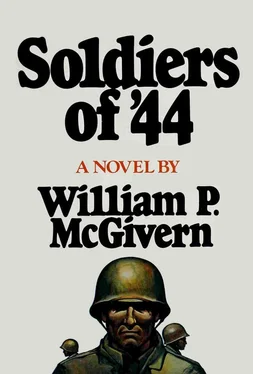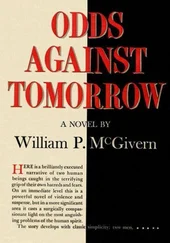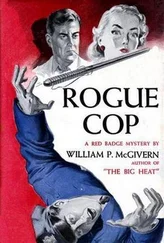They listened to an announcer speaking in French from Paris, and a U.S. Armed Forces reporter repeating the first comments on the cease-fire from General Eisenhower in France and President Truman at the White House. There were bursts of music and a recapitulation of the sequence of events by Armed Forces announcers, details of the German surrender and snatches of interviews with soldiers and civilians in the streets of London and New York. In a final interval of windy silence, there was a hush, an almost reverent stillness, and then, suddenly and jubilantly, came the sound of the big bells tolling from Westminster Abbey and Notre Dame in Paris.
Docker went back to the cannon and listened to the thin music of whistles drifting toward them now from captured German cities on both sides of the Rhine. He lit a cigarette from Karsh’s lighter with First Army insignia on its sides — a square black A on a gray field — and looked at Trankic.
“Let’s take care of that unfinished business now.”
“I guess we’d better,” Trankic said.
Picking up a clip of ammunition, Docker climbed onto the loading platform of the cannon. Tex Farrel joined him inside the revetment and secured the lever that locked the cannon into the directional apparatus. Trankic adjusted the azimuth and elevation scopes to the smokestack, and the barrel swung swiftly around to focus on it.
Docker looked across the river and studied the thin patch of daylight at the top of the chimney. “What about it?” he said to Trankic.
“What about what. Bull?”
“Think we could put a few rounds through that hole up there?”
“Sure,” Trankic said, and turned the operation wheels slowly, bringing the cross hairs of the sights in line with the jagged hole at the top of the smokestack.
The rest of the men had crowded around the rear of the revetment. “You guys are fucking gonna see something now,” Kohler said to the recruits who were bunched together in defensive isolation from the veterans.
“They’ll see it but it’s not like the wretched way it was,” Dormund said.
Docker slammed his foot down on the firing pedal. The sound of the cannon was all around them, the glowing tracers describing high arches of fire as they crossed the river toward the smokestack standing above the debris on the opposite shore of the Rhine.
When the first six rounds of ammunition, tracking each other at fifty-yard intervals, flashed through the circle at the top of the black chimney, there was a cheer from the soldiers, and another when the projectiles curved to the ground thousands of yards beyond the river to explode like strings of big firecrackers.
Docker called to Trankic, “Let’s take it down now!”
Trankic fed the adjustments into the director and the gun barrel dropped sharply, its flared muzzle zeroing in on the base of the smokestack, and when it locked there Docker hit the firing pedal and another stream of tracers soared over the river.
They struck the base of the chimney, the warheads exploding in rapid bursts, and the length of the stack shuddered as if the ground beneath it had twisted violently, and then the huge chimney began to tumble and fall in graceful patterns as slowly as if it were melting toward the ground, the bricks detaching themselves from the main shaft and spinning lazily through smoke rising from the exploding artillery shells.
Docker put the cannon on safe and listened to the sound of bells and whistles in the winds and watched the huge smokestack collapse in powdered heaps along the far bank of the river.
When the last of the explosions had come like winter thunder through the settling dust and smoke, when the air was clear again. Docker and his men saw that the distant stretches of earth were flat as a man’s hand from the silver shores of the Rhine to as far as they could see into the heart of Germany.
CORPORAL EDWARD G. SOLVIS was honorably discharged from the United States Army at Camp Grant, Illinois, four months after the end of the World War II. At a Lions Club luncheon given in his honor by the president of Citizens’ Trust of Davenport, Iowa, Solvis was informed that he had been promoted to assistant cashier and appointed to the bank’s pension and credit union committees. As an additional gesture of appreciation, his years of wartime service was credited to his seniority at Citizens’ Trust.
After adjusting himself to the routines of civilian life, Solvis assembled his notes and wartime diaries in chronological order and began to prepare an informal history of the unit in which he had served.
He corresponded with the surviving members of Section Eight, sent them questionnaires to fill out and, as his original design expanded, addressed inquiries to other individuals and organizations who might have had information about or related in any way to the section. When this work was as complete as he could make it, Solvis asked Buell Docker to assist him in finding a permanent repository for his files and records and diaries. It was through Docker’s contacts that the permanent Edward G. Solvis Collection was established at the College of Pennsylvania.
The following information is from the Solvis Collection in the archives of the college at Ardmore, Pennsylvania.
PRIVATE FIRST CLASS JOSEPH PITKO: His body was never recovered or accounted for by Graves Registration. Private First Class Pitko is still carried on the battalion roster as MIA (Missing in Action) in the Ardennes Campaign.
PAUL BONNARD: Widowed, with three grandchildren, Bonnard lives at the gatehouse and continues to tend the grounds of Château Rêve, converted now into a retirement home for the Order of the Sisters of the Sacred Heart.
PRIVATE FIRST CLASS IRVING GRUBER: Gruber is buried in the family plot at the Beth Shalom Cemetery in the borough of Brooklyn, New York. His headstone lies between that of his mother and his older sister, Hilary.
PRIVATES FIRST CLASS LEO PIERCE AND CARMINE SPINELLI: They are buried in the Netherlands-American Military Cemetery in Margraten, Holland.
JOCKO BERTHIER: Under a war reparations act, Berthier was granted fifty thousand Belgian francs as compensation for the injuries he suffered during the German occupation of Lepont. He was later awarded Belgium’s third highest civilian decoration for his voluntary assistance to the American gun crew at Lepont during the Battle of the Bulge. Berthier sent Solvis several photographs of his enlarged and renovated cafe-bar, which now occupies two additional storefronts facing Lepont’s old church.
PRIVATE FIRST CLASS CHESTER DORMUND: Answered only one inquiry. After his discharge from the Army, Dormund worked as a short-order cook in Sweetwater, Texas. On his nights off, he wrote, he liked to watch the harness races and “bet a little money on the wretched trotters.”
CAPTAIN WALTER “DER HENKER” BRECHT: Captain Brecht left a widow and two sons in Frankfurt-am-Main, Germany. During the Allied occupation, Frau Brecht contributed her husband’s library of Spanish and Portuguese plays to the American Armed Forces Library at Munich. Solvis learned of this from an article in the service newspaper, Stars and Stripes, which listed the specifics of Frau Brecht’s bequest in a story outlining the cultural opportunities available to GI wives in Germany.
FIRST SERGEANT MILES KORBICK: Released from an Army hospital in Georgia in 1947, Korbick was discharged from the army the same year. He opened one of the first laundromats in Florida — “Korbick’s Korner” — which was the beginning of a chain that has expanded into seven southern states.
PRIVATE FIRST CLASS SAMUEL GELNICK: His body was returned to the United States at the request of his wife, Doris. Gelnick is buried in the Star of David Cemetery in the borough of the Bronx in New York.
Читать дальше

![Уильям Макгиверн - Завтра опять неизвестность [английский и русский параллельные тексты]](/books/35168/uilyam-makgivern-zavtra-opyat-neizvestnost-angli-thumb.webp)









